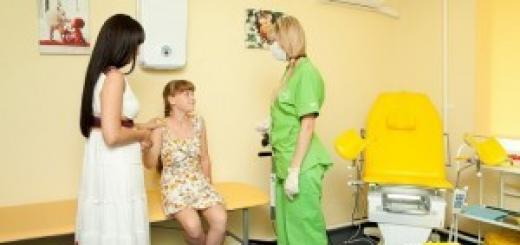During 9 months of pregnancy, a woman’s body, both inside and outside, undergoes enormous changes. Carrying a child and preparing for childbirth causes changes in almost all systems and organs of the pregnant woman. Therefore, after the birth of the baby, the woman’s body must again go through a period of adaptation in order to return to its previous state. Physical exercises after childbirth (with the permission of the gynecologist, of course) will help with this.
Often, for the first time after the birth of a baby, young mothers are not very concerned about their appearance; they are busy with other joyful chores. However, after a few weeks, the realization comes that the reflection in the mirror has changed a little, and this further increases the psycho-emotional load. It is very important for a woman to feel attractive, so you need to take the time and find a suitable set of exercises after childbirth to restore your former figure and regain your confidence.
What transformations happen to the body after childbirth?
On average, the postpartum period lasts 6-8 weeks. During this time, the endocrine, reproductive, digestive, cardiovascular and musculoskeletal systems change. The process during which reverse transformations occur in systems and organs after pregnancy is called involution.
Changes in the endocrine system
Immediately after childbirth, the production of estrogen and progesterone begins to decrease. Metabolism slows down and body weight subsequently increases due to decreased fat oxidation. The skin of a young mother becomes drier and less elastic, and may appear. The hormone oxytocin is actively released, which promotes contraction.
The pituitary gland produces luteotropic hormone, which is responsible for lactation. First, colostrum is released, a yellow-transparent fatty substance that provides the newborn's first protection. 3-4 days after birth, milk begins to be produced. The breasts swell, sometimes increasing by 2-3 sizes.

Genitals after childbirth
Normally, the size of the uterus is restored by the 8th week after the birth of the child. The weight of the uterus after childbirth is about 1.5 kg; in 2 months its weight should decrease by 30 times. This process very much depends on the principle by which the child is fed. In women who cannot breastfeed, the decrease in volume occurs much more slowly. They need to learn exercises to contract the uterus after childbirth.
The cervix returns to its original size after 3 weeks, but instead of a conical shape it becomes cylindrical. The inner lining after childbirth is a wound that must be given time to heal. Therefore, you need to carefully observe genital hygiene, and it is better to postpone sexual activity for 1.5-2 months. At the same time, the vagina also takes on its original shape. To maximize the restoration of the muscular walls of the vulva and the function of the pelvic floor, you can do Kegel exercises after childbirth.
Discharge in the postpartum period
In the first 3-4 days of the postpartum period, the discharge (lochia) is bright red and resembles heavy menstruation. Over time, they acquire a pink-gray tint, and there are fewer and fewer of them.
For breastfeeding mothers, menstruation occurs after the end of breastfeeding or when breastfeeding becomes very rare. However, it is important for women to remember that already six months after the birth of a child, even during lactation, ovulation often occurs, so unprotected sexual intercourse can lead to pregnancy. If a woman does not breastfeed her baby, her period comes 1.5-2 months after birth.
What happens to other systems
Since many internal organs shift during pregnancy due to the growing uterus, changes affect the digestive and urinary systems. Possible slowdown in peristalsis, constipation, etc. Therefore, a woman should monitor her diet and pay attention to the regularity and quality of stool.

A decrease in tone in the bladder after childbirth often causes a lack of urge to urinate, which threatens to overfill the organ and reduce contraction of the uterus. Because of this, the discharge of lochia slows down and inflammatory processes are provoked. Moderate exercise 6-8 weeks after birth helps restore these functions.
After the birth of a child, a woman loses a large amount of body weight, and the load on the cardiovascular system is significantly reduced. The body does not always have time to quickly adapt, so compensatory tachycardia may appear.
The musculoskeletal system of a pregnant woman has been adapting to a shift in the center of gravity for 9 months and should be adjusted back after childbirth. Ligaments, muscles, joints and spine get used to the new position of the body in space.
Often the muscular system is weakened, which can cause pain. The abdominal muscles may separate, forming a diastasis, which causes the belly to protrude and make it appear as if the woman is pregnant again. And this is not only an aesthetic problem, but also the risk of a hernia. To avoid such a problem, a woman should know what exercises she needs to do to recover after childbirth.
How to quickly get back into shape after childbirth?
During childbirth, about 5-7 kg are lost, which accounts for the weight of the child, placenta and amniotic fluid. Within a few days after giving birth, several kilograms of excess fluid accumulated during pregnancy are lost. Further changes in weight and figure depend only on the woman herself.
Decreased production of estrogen and progesterone slows down metabolism, which contributes to the accumulation of extra pounds if proper nutrition is not followed. At the same time, lactation takes a lot of strength and energy from the body - about 500 kcal per day, which is what causes increased appetite in nursing mothers.
There is an opinion among people that both a pregnant woman and a nursing mother should eat for two. But this is not true; you should adhere to a balanced diet, rich in fiber, proteins and dairy products and avoid fatty, sweet and rich foods.
In addition, already a couple of weeks after giving birth and in the absence of contraindications, you should start doing exercises to restore your figure.

In order for sports to be beneficial, enjoyable and effective, you need to follow simple instructions:
- consult a doctor before starting classes;
- choose a gentle set of exercises and do not overexert yourself;
- do not try to lose weight quickly;
- systematically but slowly increase physical activity;
- breathe correctly and do not make sudden movements;
- exercise in comfortable clothes in a well-ventilated area after feeding;
- exercise regularly;
- listen to your own body.
Exercises to contract the uterus
To speed up involution, just a few days after birth you can perform exercises for the uterus:
- Lie on your back, bend your knees. Smoothly straighten them and bend them back 10 times. On the last straightening, clench your toes into a “fist” 10 times.
- Lying on your back, bend your knees. Straighten one leg and pull the toe as close to you as possible 10 times. Repeat the same with the second leg.
- Lie on your back with your legs extended and slightly apart. Place your hand on your stomach in the area below the navel. Take a deep breath through your nose, rounding your stomach. Release the air noisily through your mouth and draw in your stomach as much as possible, helping with your hand in the direction from the pubis to the navel. Repeat 10 times.
- Repeat exercise 3, but lying on your side, 10 times.
- Leaning on your elbows, lie on your stomach and place a thick pillow under it. Repeat the breathing exercises, while exhaling, press your pelvis as much as possible into the pillow.
Arnold Kegel exercises will help restore intimate muscles. They can be done anytime and anywhere:
- Squeeze the muscles of the vagina and anus alternately for 10 seconds. Between exercises, take a 10-second relaxation break. It is important to ensure that the facial muscles are relaxed. You need to devote 5 minutes a day to such “charging”.
- Repeat the previous exercise, but at an accelerated pace - 1 second each.

You need to start exercises after childbirth to contract the uterus and Kegel exercises, like any other exercise, with minimal physical activity. These exercises increase blood flow in the genitals and contribute not only to their restoration, but also improves the quality of intimate life due to increased sensations.
How to get a flat stomach after childbirth
Before starting classes, you need to remember that immediately after childbirth, the abdominal muscles need to be treated very delicately. Abdominal exercises after childbirth should be smooth and gentle. Overload and sudden movements can aggravate the situation and provoke diastasis. Therefore, they should begin to be done 6-8 weeks after birth, and after cesarean - after 2-3 months.
Here are some of the most successful and effective exercises:
- Lie on your back, bend your knees. Place your arms, bent at the elbows, behind your head. Lift your shoulder blades off the floor and pull yourself towards your knees. The chin does not reach towards the chest. Hands do not push the neck. Repeat 20 times.
- Lying on your back, raise your legs and bend your knees at a right angle. Using your abdominal muscles, lift your pelvis up. Repeat 20 times.
- Lie on your back, bend your knees and tilt them sideways onto the floor. Repeat the movements as in the first exercise 15 times. Change the position of your legs to the other side, repeat 15 times.
- Lying on your back, raise your legs at an angle of 45 degrees. Place your arms bent at the elbows behind your head. Bend your left leg and try to reach your knee with your right elbow, lifting your shoulder blades off the floor. Repeat the same with the right leg and left arm. Do 20 times.
There are many sets of exercises for losing weight after childbirth. Don't just focus on the press. It is necessary to train all muscles at once - this is more effective. Six months after giving birth, you can start intensive training as usual and go to the gym or group training, but everything is assessed individually. Many people like to exercise on a fitball after giving birth. Exercises on the ball improve your mood and can be done even with a baby in your arms, he will also like it.
How to get your breast shape back
During breastfeeding, breast tissue stretches, glandular tissue is replaced by loose connective tissue, muscles weaken and the breasts sag, taking on a completely unaesthetic appearance. Getting back in shape is more difficult than losing weight or pumping up your abs, but by doing daily chest exercises after childbirth, you can regain the tone of your pectoral muscles and not be afraid to wear clothes with an open neckline.

The most effective exercises:
- Stand up straight. Bring your palms together in front of your chest and press one on the other with force for a few seconds. Repeat 8 times.
- Raise your arms at head level. Grab your left elbow with your right hand and your right elbow with your left hand. Forcefully press your forehead onto your hands. Repeat 8 times.
- The starting position is the same as in exercise 2, but put your hands behind your head and press with the back of your head. Repeat 8 times.
- Place your hands on the wall and press on it with your palms, as if you want to move it. Repeat 8 times.
- Push up from the floor, but with emphasis on your knees. Bend your chest towards the floor as low as possible. Repeat 10 times.
- Make hand swings like a mill. Forward and backward 8 times.
By performing such exercises during feeding, you can increase blood circulation in the mammary glands, thereby improving lactation.
To keep your breasts beautiful and firm, you need not only to do exercises, but also to properly latch on to your baby, wear comfortable underwear, and use special cosmetics to restore skin elasticity.
Each of us wants to restore our figure as quickly as possible after childbirth. When can you start exercising after giving birth? We will tell you how to become slim again and not harm your body.
Rehabilitation exercises after childbirth
The birth of a baby is a new stage in a woman’s life. A young mother devotes herself entirely to caring for her child, leaving virtually no time for herself. But you really want to fit into your favorite “pre-pregnancy” jeans faster.
When can you exercise after giving birth?
During pregnancy and childbirth, the body is exposed to enormous stress. The figure changes, usually not for the better. Excess weight and a sagging belly do not add optimism to a young mother, who had already suffered a lot of stress the day before. Don't panic. The problem of excess weight will not resolve on its own, but it can be helped.
Only your gynecologist can tell you when to start exercising after giving birth. If the birth was natural, without ruptures or stitches on the perineum, then light exercises can be performed almost immediately after childbirth.
So, when can you start exercising after giving birth? Some mothers begin doing gymnastics already in the postpartum ward. If there are no contraindications from a doctor, then the woman’s health is not in danger. On the contrary, light physical exercise promotes rapid contraction of the uterus, toning the abdominal muscles, milk flow, and weight loss.
If there were complications or a caesarean section, gymnastics immediately after childbirth is contraindicated; when to start, only the attending physician can tell after an examination.
At first, it is advisable to perform gymnastics on a hard bed in a well-ventilated room. If your baby is breastfed, it is better to start exercises after the baby's feeding session. Remember that your milk supply may decrease at your next feeding. This can be caused by fluid loss during exercise, so it is important to stay hydrated and be sure to drink water during or after exercise.
It is important to introduce loads gradually. Then it will not affect the quality of the milk. Intense exercise can cause the production of lactic acid, which passes into breast milk and changes its taste.
How long after you can do abdominal exercises after giving birth? In two or three months. Before this period expires, running is also not recommended.
What exercises can you do after giving birth?
You can start doing light gymnastics within a day after the baby is born. The main rule of sport is gradualism. Don't start intense training right away. This can harm an already weakened body and change the taste of milk, which can cause the baby to refuse the breast.
If you are still in the maternity hospital, you can consult with your gynecologist, who will advise what physical exercises you can do after childbirth specifically in your case. When doing exercises, be extremely careful, even if you had childbirth without surgery.
Below we will tell you what exercises you can do immediately after giving birth. We propose to consider exercises for different muscle groups, which will help not only return to their former shape, but will also contribute to the rapid restoration of the internal organs of the small pelvis and the body as a whole.
What exercises should you do after childbirth:
- recovery;
- losing weight;
- strengthening the abdominal muscles;
- breasts;
- uterine contractions;
- back and spine muscles;
- breathing exercises.
By performing these complexes several times a week, you will quickly get back into shape, and perhaps become even slimmer than you were before pregnancy.
A set of exercises for recovery after childbirth
During the postpartum period, a serious restructuring begins in the girl’s body: the hormonal levels change, the uterus contracts, and gradually the internal organs fall into place. This process takes some time - from 2 to 6 weeks. Experiencing discomfort (pain in the back and perineum, nagging pain in the lower abdomen), a young mother wants to recover after childbirth as quickly as possible. Regenerative gymnastics will help improve your quality of life and help your body during the postpartum period. A set of simple and safe exercises will not take much effort and time. It can be done at home in any free minute.
Starting position: lying on your back, knees bent, legs apart. Try to move your knees with force while your helper (the ball) counteracts.
Another option for a simple exercise for women that will be effective for recovery after childbirth. You need to lie on your back and strain your perineum. Perform at least five times.
These simple physical exercises will help speed up the recovery process after childbirth.
A set of exercises for losing weight after childbirth
How to lose belly fat after childbirth? Perhaps the most pressing question for young mothers. Pregnancy, the accompanying hormonal changes, increased appetite and a sedentary lifestyle negatively affect your figure. After childbirth, a simple set of exercises will help to restore your figure, aimed at activating metabolic processes and improving blood flow in muscles and tissues.
Lie on your side, bend your knees. Place the palm of your lower hand under your head, and rest your upper hand on the bed at the level of your navel. From this position, try to lift your pelvis, resting on your palm. Perform 3 to 10 repetitions on each side.
Lie on your back, bend your knees. The arms are extended along the body. When performing the exercise, you need to alternately stretch your hands with a sliding movement along the surface of the bed, either to the right or to the left foot. Do 5-10 repetitions in each direction.
Standing on all fours, while inhaling, raise your left palm and right knee, then change the diagonal. Perform from 3 to 10 repetitions.
It is advisable for a nursing mother to perform exercises to lose weight after childbirth after feeding. To prevent your milk supply from decreasing, it is important to monitor fluid loss.
Your doctor will tell you what other exercises you can do to adjust your waist and remove your belly after childbirth.
A set of exercises to strengthen the abdominal muscles after childbirth
Abdominal exercises are recommended to be performed no earlier than one and a half months after giving birth. It is better to start exercising from 6-8 weeks after natural birth and 2-3 months after cesarean section. If you put stress on this muscle group earlier, the stitches may come apart and intrauterine pressure may increase. There is also a risk of vaginal wall prolapse.
To begin with, you should choose exercises for tummy tuck from Pilates or yoga, which will be safe for the woman’s body after childbirth.
If you have diastasis after childbirth, classic exercises to strengthen your abdominal muscles are contraindicated for you.
Exercises for breast reconstruction after childbirth
If for some reason you do not plan to breastfeed, breast exercises can be performed as early as 2 weeks after birth. If you are breastfeeding, then you can start a set of exercises after stopping feeding.
Classic exercises for working the pectoral muscles after childbirth:
Starting position: elbows raised at shoulder level, palms touching. Squeeze your palms for a few seconds, then lower your elbows. Perform 10 times.
Starting position: arms raised to shoulder level and spread to the sides. Move your arms back, then lower. Repeat 10 times.
Exercises to contract the uterus after childbirth
The process of involution (contraction of the uterus) can take from 6 to 8 weeks. During this period, the organ falls into place and regains its previous size. In addition to breastfeeding and wearing a postpartum bandage, special gymnastics to contract the uterus will help speed up this process after childbirth, which serves to prevent stagnation of blood in the uterus and promotes its fastest healing.
Exercises to restore the uterus can be started immediately after childbirth and continued for 10-12 weeks. The complex may include Kegel exercises, abdominal retraction, diaphragm breathing, etc.
Before performing exercises for the perineum and uterus after childbirth, be sure to consult your doctor.
Back strengthening exercises after childbirth
Often women who have given birth experience severe pain in the lumbar region. This is due to the restructuring of the body, in particular the spine. Back exercises will help relieve tension in the paravertebral muscles after childbirth and relieve discomfort.
Yoga asanas - twisting and stretching exercises - will be very effective.
Breathing exercises after childbirth
Breathing exercises are also recommended to restore the body after childbirth. Its action is aimed at improving blood circulation and accelerating metabolic processes in the body. Breathing exercises will also help strengthen your abdominal muscles after childbirth.
The gymnastics is performed as follows: placing your hands on your ribs under your chest, take a slow and deep breath through your nose, while inflating your stomach. Then exhale slowly through your mouth, drawing in your navel. Make sure your shoulders remain motionless.
Fitball exercises after childbirth
Fitness on a fitball is also done during pregnancy. You can perform the same exercises on the ball after childbirth, gradually increasing the load. But before that, be sure to consult with your doctor.
Exercises on a fitball for losing weight after childbirth are different types of stretching, twisting, and rocking. The effectiveness of training with a gymnastic ball is very high. In addition, they can be performed together with the baby. For example, sitting on a ball, spring while performing turns left and right. The baby can be held in your arms at this time.
Kegel exercises after childbirth
Kegel exercises, named after the American gynecologist, are effective both during pregnancy and after childbirth. Simple exercises can strengthen the deep muscles of the pelvic floor, promote rapid contraction of the uterus, improve blood circulation in the internal organs, and heal the perineum. After giving birth, you can do Kegel exercises while you are in the postpartum ward. You must continue to do them at home for 10 weeks. The exercises consist of tensing and relaxing the deep muscles of the pelvic floor.
To understand how to do Kegel exercises after childbirth, try holding the stream while urinating. Remember which muscles you used.
How long after giving birth can you do Kegel exercises if you had an episiotomy, check with your gynecologist. It is not recommended to start doing such gymnastics earlier than a week later.
During the period when a woman carries her unborn baby for nine months, a significant restructuring occurs in almost all systems of her body. Due to the increased overall load and hormonal changes The woman’s weight increases, and as a result, after the birth of the baby, the young mother remains extra kilos.
Without a doubt, every young mother wants to return to her previous shape as quickly as possible. But in the postpartum period, the body is weakened, a reverse restructuring of all systems occurs, and very often, in order to return to the previous weight, you have to not only limit yourself in nutrition, but also ensure sufficient physical activity.
In general, the postpartum period lasts about eight weeks: during this time, the restructuring of the body occurs most actively. Due to such high tension, doctors do not advise practicing too much physical tension at this time. But still postpartum gymnastics can gradually be introduced into the lifestyle of a young mother from the first weeks. The main condition is that exercises in the first days after childbirth should be as gentle as possible, and the load can be increased gradually, from day to day.
Basic rules of postpartum gymnastics
It is optimal to start playing sports after the birth of a child only after consulting with your doctor: he will be able to determine whether the recovery process is proceeding normally and will tell you which exercises can be practiced now, and which loads are best avoided for now.
The main task facing a woman who intends to gradually introduce postpartum gymnastics into her daily routine is the restoration of posture, gait, and the return of the normal tone of all muscles that have lost elasticity during the period (in particular, we are talking about the pelvic floor and abdominal muscles).
Also, gymnastics after childbirth helps to return the pelvic and abdominal organs to their normal position, activates blood circulation, breathing, and helps normalize the state of the nervous system.
In order for postpartum gymnastics to bring maximum benefit to the young mother and contribute to both physical and emotional recovery, several important points should be taken into account.
When starting to do exercises every day, you need to go from simple to complex, gradually increasing the load. It is advisable to perform a set of exercises every day that is at least slightly different from the previous one. Boring gymnastics, monotonously repeated day after day, can negatively affect the general condition of the body and have no effect in terms of weight loss. In addition, there is a high risk that such activities may simply bore the young mother.
In the first weeks of classes, gymnastics should be performed every day. When the intensity of physical activity and the total duration of the session increases significantly, the number of such workouts can be reduced to 3 times a week.
A woman who has recently given birth to a child should perform all movements smoothly and slowly; if necessary, immediately make a short stop and restore breathing.
For training, you need to choose suitable clothes - comfortable, not restrictive to the body. Recumbent exercises should be performed while lying on a flat floor surface. Before training, it is important to thoroughly ventilate the room so that during the exercises the woman deeply inhales clean and fresh air.
Before starting gymnastics, a young mother must empty her bladder and bowels. It is advisable to take a thoughtful approach to the time of training: it is optimal to do a set of exercises about one hour before meals and after the baby has finished feeding. The fact is that in the process of intense loads, production occurs lactic acid , which can change the taste of milk. If you exercise too much, milk production may decrease slightly. Therefore, it is recommended both during physical training and after performing exercises to drink as much fluid as possible - preferably plain clean water.
During the postpartum period, the preferred types of physical activity are walking with a stroller and swimming. In winter you can go skiing and ice skating. But with strength exercises, cycling, running, as well as extreme exercises and sports, it is advisable to wait at least a few months.
Exercises from the postpartum gymnastics complex in the first days after childbirth
Whatever set of exercises a young mother chooses, before starting the main part, you should do a short five-minute warm-up. If a woman exercises for at least an hour, then warming up can take up to ten minutes.
The beginning of the warm-up can be deep breathing - several very deep inhalations and exhalations. Next comes the stretching: you need to stretch up, then bend down and touch the floor with your fingers. The warm-up can include wide arm swings in different directions, up and down, and steps in place.
Almost the next day after the birth of the baby, provided there are no complications and good health, the new mother can perform simple exercises.
While lying down, you can twirl your hands at face level for several minutes, imitating washing in a unique way. In the same position, you need to tuck your legs one by one, sliding them along the surface of the floor.
While lying down, you should lift your pelvis up. In this case, the legs are bent at the knees, and the hands are behind the head. You can sit down several times from a lying position, while waving your arms, trying to reach your toes. It is also recommended to perform light movements, making a “bicycle”. Then you can roll over onto your stomach and, clasping your hands under your chin, lift your legs one by one, holding them a little in a suspended position. You can also lift your legs up one at a time while standing on all fours. All exercises are performed ten times. After this, clench and unclench your toes ten to fifteen times. These simple exercises are useful both for preventing the development and for training weakened abdominal muscles.
There are other postpartum gymnastics complexes that can be practiced the very next day after a grand event in the mother’s life. Exercises that involve deep breathing are very useful. It is important that the lower abdomen is involved in the process of inhalation and exhalation.
For the first exercise, you need to lie on your back and bend both legs at the knees. Hands are on the stomach. Inhale through the nose, slowly, exhale through the mouth. When exhaling deeply, the stomach should be stroked from below to the navel. It is important that no pressure is applied to the abdomen: movements should be light. This exercise is repeated 15-20 times. After this, the woman should roll over onto her stomach. To make lying more comfortable, place a small pillow under your stomach. Breathing is done from the lower abdomen, it should be as deep as possible. When you exhale, the pelvis moves upward. Such exercises help improve the functioning of a woman’s cardiovascular system, activate blood flow, stimulate metabolism . In addition, by performing breathing exercises for several weeks, you can perfectly prepare your muscles for further more intense exercise. The total duration of gymnastics in the first days after childbirth should not exceed 10-15 minutes. But you can perform such simple workouts several times a day. But it is extremely important that a woman under no circumstances exercise too intensely in the first days after giving birth: she absolutely must not overexert herself.
Women who have suffered , should postpone physical activity until your doctor allows you to do light exercises.
Already in the maternity hospital, the young mother should remember the so-called Kegel exercises . To perform this exercise correctly, the pelvic floor muscles need to be pulled in as you inhale and relaxed as you exhale. Gymnastics afterward must necessarily include such an exercise, since it is extremely important for restoring the elasticity of the vaginal muscles. In order for muscle tone to be restored as quickly as possible, this exercise should be repeated every day at least a hundred times, performing it in several approaches throughout the day.
All the described exercises can be varied at your own discretion. There is no need to perform those that cause a persistent feeling of discomfort. The main thing is that the activity brings pleasure, and after it there is a feeling of vivacity, and not fatigue.
Exercises from the postpartum gymnastics complex during the recovery period
 Around the third week, more complex exercises can be introduced into the postpartum gymnastics complex, which help strengthen the tone of the body muscles. It is advisable to diversify the set of exercises in a lying position. So, you can perform alternate leg lifts: straightening your leg at the top, a woman can hold her leg in this position and work with her toe, alternately pulling it towards her and pulling it back. On the following leg lifts, you should make rotational movements. Repeat lifting each leg 15-20 times.
Around the third week, more complex exercises can be introduced into the postpartum gymnastics complex, which help strengthen the tone of the body muscles. It is advisable to diversify the set of exercises in a lying position. So, you can perform alternate leg lifts: straightening your leg at the top, a woman can hold her leg in this position and work with her toe, alternately pulling it towards her and pulling it back. On the following leg lifts, you should make rotational movements. Repeat lifting each leg 15-20 times.
In a lying position, the arms are extended along the body. As you exhale, your legs should be pulled toward your chest one at a time. The exercise on each leg is repeated 6 times. After completing the approach, you should straighten up, stretching out in a string: your toes are pulled in one direction, your fingers in the other.
Lying on your stomach, your hands should be folded under your forehead with the back of your head. Exhaling air, lift your upper body up. Hands remain pressed to the floor surface. You cannot throw your head back: it is in line with the spine. The lift is repeated 6-7 times.
It is useful to introduce the well-known “cat” exercise into the general complex of postpartum gymnastics: to perform it, you need to get on all fours and bend your back as much as possible, rounding it. While performing this exercise, you should also retract the muscles of the perineum.
An exercise is also performed on all fours, which helps strengthen the tone of the muscles of the perineum and abdomen at the same time. To do this, you need to lower yourself onto your elbows, exhale air and bring your shoulder blades together. As you inhale, the shoulder blades spread, and the back rounds as much as possible, as in the case of performing the “cat”. Remaining in this position, you should retract the perineum and abdomen as much as possible. As you exhale, maximum relaxation follows.
Another exercise should be performed while sitting on a chair. In this case, you need to straighten your back as much as possible and pull in your stomach. The legs are located approximately shoulder width apart. In this position, bends to the sides are performed. In this case, you need to reach the floor with your palm. You need to bend over 6-7 times in each direction. However, for women who had sutures placed on the perineum during childbirth, it is better not to perform sitting exercises for several more weeks. You can also bend to the sides alternately from a standing position: this exercise helps shape the waistline.
In a standing position, you can do any simple exercises aimed at training the abdominal muscles, arms, and legs. Exercises that include movements of the pelvis are useful: for example, standing on your knees slightly bent (with your legs together), you should swing your pelvis back and forth, draw a circle in one direction and the other. When performing rotational movements, you should try to strongly retract your stomach. As you inhale, you need to stop, as you exhale, continue moving forward.
 After completing a set of exercises, you should rest a little, lying on the floor on your stomach or back. In this case, breathing should be very deep.
After completing a set of exercises, you should rest a little, lying on the floor on your stomach or back. In this case, breathing should be very deep.
At home, it is useful to include several exercises with dumbbells in the general complex of postpartum gymnastics. So-called resistance exercises to strengthen muscles are performed with light dumbbells (their weight should not exceed 1 kg).
In addition, after the postpartum 6-8 weeks, you can perform full abdominal exercises (sit down from a lying position), do push-ups from the floor.
Another option for quite fun postpartum gymnastics is doing exercises together with the baby and dad. While the child is small, he can act as a kind of “projectile”: the baby can be lifted on bent legs, squatted with a kangaroo backpack in which the baby is sitting. And later, the baby will gradually get used to the fact that daily gymnastics is the norm. In addition, activities with the mother always bring joy to a rapidly growing child.
Gymnastics after childbirth is an integral part of the complex aimed at the complete and effective return of the body to its usual, prenatal state. The sooner you start doing physical exercises, the sooner you will finally return to your usual proportions.
- We recommend reading:
Your figure changed during pregnancy and you want to return to your previous proportions after giving birth? But are you afraid to do gymnastics because you have heard about the dangers of physical activity in the postpartum period? Let's dispel some myths about not exercising after childbirth.

- “I just gave birth, my body is weakened, I’m not able to do gymnastics to lose weight and tighten my stomach.”
The first four weeks after the maternity hospital, gymnastics is contraindicated only for those who have undergone childbirth by cesarean section, the natural consequence of which was sutures. The rest are recommended to start doing simple gymnastics already in the ward of the maternity hospital.
- “I will go on a diet to lose weight.”
Dieting helps you lose weight – it’s a reliable fact. However, will a diet help normalize stretched transverse muscles and strengthen the rectus abdominis muscle?
- “I don’t have time, because caring for a child eats up all of it.”
You don’t even suspect that you are doing simple exercises in combination with while you cook, wash, clean, or carry a child in your arms.
The issue of losing weight is a sore subject for women returning home after maternity hospital. Since resorting to diets is strictly not recommended for nursing mothers, all that remains is gymnastics for weight loss.
What kind of gymnastics can you do?
To strengthen the abdominal muscles, you need to systematically resort to several simple exercises. This gymnastics does not require even five minutes a day and, with proper regularity, will give a noticeable effect.
There are many known sports techniques developed by eminent masters. Difficult to perform, taking too much time from young mothers. It is better not to use such complexes in the first months after childbirth. Below are basic and effective exercises that will help you achieve tangible results in the shortest possible time.
Abdominal retraction
Lay a gymnastic mat on the floor surface and begin the exercise. Take a position lying on your back, bend your knees and firmly press your feet to the floor. Place the palms of your hands on your stomach, exhale strongly, and at the same time tense your abdominal muscles. Hold this position for 4 seconds. After the specified period, take a full, leisurely breath. Repeat the exercise at least eight times in one approach.
Bridge
The exercise is not similar to the “bridge” that gymnasts perform at world championships. After childbirth, gymnastics is exclusively health-improving in nature. Therefore, take a position similar to the one you occupied when performing abdominal retraction. Place your hands behind your head, weave the phalanges into a lock. Exhale strongly and lift your pelvis 20-25 cm from the floor, while simultaneously drawing in your stomach. You will definitely feel how your buttock muscles tighten.
The exercise may be difficult for beginners. Therefore, do not be alarmed if it turns out to be difficult or even impossible to complete the first time. Start with a small number of repetitions, gradually increasing the pace and load. For women who are in good physical shape, we complicate the process by pressing the chin to the chest, simultaneously with raising the pelvis.
Breathing exercises
Having completed the bridge exercise, not in my position, we move on to the next exercise. Bend your knees, with your feet 20 cm apart. Place your hands on your stomach, palms down. Calm your breathing and take a slow, full breath. Exhale just as calmly, accompanied by the sound “haaa”. As you exhale, draw in your stomach while stroking with your hands. Directional strokes should be performed carefully and effortlessly, from the pubic area to the navel area. Perform up to 10 repetitions.
The following exercise is suitable as a method for strengthening the abdominal muscles after childbirth. Lie on your stomach with a pillow under it. Transfer your body weight to your elbow joints. Inhale, then as you exhale, move your pelvis forward. Simultaneously with the next inhalation, return to the starting position. Be careful not to put excessive pressure on your chest.

Vertical press
Starting position – standing facing the wall. Place your hands on the wall in such a way as to ensure a tight fit between your hands and forearms. Bend your legs slightly at the knee joints, place them shoulder-width apart. Contract your abdominal muscles as if you were stretching your left elbow towards your right knee, then vice versa. In fact, it turns out that muscles work without performing movements.
Elimination of varicose veins
To perform the exercise, go to the “lying on your back” position. Bend your legs at the knee joints, and bring your feet together, pressing them firmly to the floor surface. The position of the hands is along the line of the body, the palms, like the feet, are pressed to the floor. After this, proceed directly to the exercise: without separating your knees, straighten your legs, while simultaneously squeezing your toes with force at least ten times. Return to the starting position. To get the desired effect, perform 5 approaches every day.
Your feedback on the article:
The guru of bodyflex breathing exercises, the only licensed specialist in Russia for body correction using breathing techniques, Marina Korpan, has developed a set of exercises that will help women who have become mothers gain a beautiful, slender figure without strict diets and exhausting workouts in the gym. In her new book, “My Slim Mom,” Marina tells how, spending no more than 25 minutes a day, you can get the body of your dreams.
Basic rules of bodyflex
- It is necessary to exercise not just on an empty stomach, but on an empty stomach. Exercising on an empty stomach forces the body to burn fat. If you eat immediately before training, your body will burn carbohydrates rather than fat.
- You don't have weekends or holidays. "Bodyflex" must be done every day within 1-2 months.
- Exercise in the morning, then your metabolism will remain elevated until the evening. And everything you eat during the day will not be stored as fat.
- Your workout should not exceed 20-25 minutes.
- Eat after training you can only in 1 hour.
Breathing technique. Stage 1. Exhale through the mouth
Stage 4. Holding your breath and pulling your stomach under your ribs
After we have done the “groin”, we hold our breath, tilt the body parallel to the floor, slightly round the upper back, direct the chin to the jugular cavity, make a throat lock (we strain the neck muscles, feeling the effect of “swallowing saliva”). At the same time, the lower lock is activated: we strain the muscles of the perineum and internal genital organs. You should feel how your internal organs rise from bottom to top, while the abdominal muscles (rectus muscle) do not participate in retracting the abdomen. At first glance, this may seem complicated, but this is exactly what needs to be done so as not to harm your internal organs and quickly achieve the effect of losing weight. Please note that simply retracting the abdomen cannot reduce the size of the stomach and, therefore, reduce appetite. And never ignore body tilt!
You will notice how your stomach will literally be sucked under your ribs. As soon as you have the first desire to inhale, be sure to inhale.
Attention!
Under no circumstances should you hold your breath for a long time in the initial stages of training. The breath hold can vary from 4 to 10 seconds.
Stage 5. Inhale
After holding your breath and performing the exercise, you can inhale through both your mouth and nose. After inhaling, the abdominal muscles relax. The most important thing that you must understand and remember at this stage is that if you hold your breath for up to 10 counts, then on the 9th count you must relax all your muscles, return to the starting position from which you started breathing, and already at rest take a breath. If you cannot withstand a delay of 10 counts, then the scheme is the same. If you want to inhale at the 5th second, then relax at the 4th and calmly inhale at the 5th count. Try repeating the breathing steps several times. Don't worry if you don't succeed the first time. It is impossible in 10 minutes to learn to breathe as you have not breathed your entire life.
Attention!
By taking a very sharp breath after holding your breath, you put a tremendous strain on the heart. You should have a natural desire to inhale, and you take a calm breath.
Exercise “Diamond”: for the muscles of the arms and chest
It is aimed at reducing fat deposits in the shoulder area, strengthening the muscles of the arms and chest.
Technique:
1. Starting position: stand straight, legs apart. Do a breathing exercise, hold your breath, pull in your stomach and take the next position.
2. Raise your arms to chest level and join your fingers to form a semicircle in front of you, as shown in the figure.
3. Round your upper back slightly. While holding your breath, begin to press as hard as possible on each other with your fingertips.
4. After 8-10 seconds, relax your arms, lower them, and inhale.










